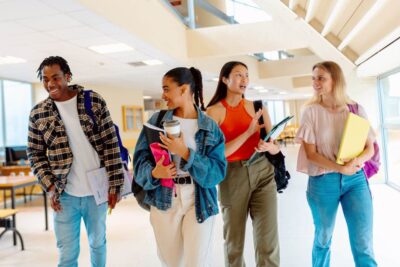3 possible student-athlete compensation models and what they mean for higher ed
It’s not clear yet what the future of college of athletics will be, but one thing is coming into focus: the era of amateurism is likely over. As part of a new EAB research project on college sports, we’ve been talking to athletic directors and university presidents about the news coming out of the NCAA. Most signs suggest that institutions, at least the Division I level, will make a radical shift and directly compensate student-athletes in the next five years through one of three models:
Although possible compensation models are beginning to come into focus, many questions remain about how these models will support equitable outcomes for student-athletes. For example, institutions will need to figure out Title IX compliance, tax implications, and how these changes will impact the student-athlete academic and social experience.
Read on to learn more about the emerging compensation models, the fundamental shifts institutions will make in how they think about athletic operations and sustainability, and the biggest news stories we’re tracking.
1. Most disruptive compensation model: Student-athletes as institutional employees
Some student-athletes have already been designated as employees by the National Labor Relations Board. This means they can unionize, engage in collective bargaining, and may be owed money for unpaid wages and overtime. This designation also opens up a “minefield of unforeseen circumstances.” We’re tracking two major cases that will determine how federal labor laws will impact both private and public institutions across the U.S.
What it means for institutions
- Institutions will be legally obligated to participate in collective bargaining, even though it conflicts with their NCAA and conference contracts.
- Even though federal labor laws only apply to private employers, this may also apply to public institutions. The way this would happen is if conferences, which are private, are designated as joint employers.
What it means for students
- Student-athletes will be able to engage in collective bargaining, which could include wages, health care, practice time, and travel.
- Student-athletes are likely most concerned about wages and healthcare.
Stories we're following
NLRB’s Trustees of Dartmouth College case
- In February, a regional NLRB director ruled that members of Dartmouth College’s men’s basketball team are “employees” within the meaning of National Labor Relations Act and have the right to a union election.
- In March, players voted 13-2 in favor of unionization and joined SEIU Local 560.
- Dartmouth has appealed, which means the case will be heard by the National Labor Relations Board in D.C. and could last months. There is not yet a timeline for the appeal. The board’s decision could be appealed again and potentially reach the Supreme Court. It could also be affected by a change in administrations.
USC football and basketball players NLRB vs Pac-12, NCAA
- This case also designates student-athletes as institutional employees.
- Notably, the case names USC, the Pac-12, and the NCAA as student-athletes’ joint employers.
- In late February, an administrative judge ruled that USC must replace the term “student-athletes” with “employees” in the players’ handbook. The case remains open, and USC can appeal.
2. Broadest-reaching compensation model: Direct institutional payment to athletes but as non-employees
Many institutions already offer education-related awards (also called Alston awards) to student-athletes, but proposals to expand this compensation could dramatically shift how D-I institutions fund their athletics departments. This model is currently being investigated by the NCAA Division I Council and could involve institutions directly signing NIL deals with players or giving direct payments to student-athletes. The impact of this shift varies based on division and conference membership.
What it means for autonomous FBS conferences
- Institutions may need to eliminate sports to make space in the budget to pay players. Institutions at or near the 14-sport minimum may be forced to choose between remaining in Division I, moving to another conference, staying compliant with Title IX, or expanding their operational deficit.
- Creating a process to select which athletes to pay may cause team culture issues and is likely to exacerbate equity issues between sports.
What it means for the rest of Division I
- Power conferences consolidate designated conference spots in NCAA tournaments and opt out of guarantee games.
- Diminished “Division I” brand pushes institutions to reclassify into Divisions II or III to save money on scholarships and sport sponsorship.
- Institutions need to create in-house collectives to navigate direct NIL deals, which may cause donor confusion and increase advancement staff workload.
What it means for Divisions II and III
- Division I institutions reclassifying into D-II/III causes market share creep, negatively impacts your enrollment, and challenges your teams’ competitiveness.
- Student-athletes pressure institutions to implement direct compensation models, causing extra strain on department budgets.
Stories we're following
Project Division I
- This proposal from NCAA President Charlie Baker includes creating a subdivision for the highest revenue-generating institutions that requires them to pay at least half of their student-athletes every year.
- Project Division I contains three primary initiatives:
-
- Allowing schools to offer enhanced educational benefits at any level they deem appropriate
- Allowing schools to enter into name, image, and likeness (NIL) agreements with student-athletes
- Establishing a subdivision within Division I that would allow higher-resourced schools to provide $30,000 of financial support for at least half of their student-athletes—in compliance with Title IX requirements.
- The Division I Council is currently reviewing the proposal and will make recommendations on the first two elements by June 2024. The NCAA’s initial timeline targets their annual convention in January 2025 for actions on the new subdivision.
3. Most popular compensation model: Revenue-sharing with student-athletes
Many athletes and coaches are advocating for—and several institutions say they’re “preparing for”—a model in which institutions split revenue from broadcasts and media deals. This model would likely mimic professional sports leagues, which means student-athletes would likely engage in collective bargaining at the institutional or conference level. The impact of this model is concentrated in Division I institutions, but current litigation also poses existential threats to the NCAA.
What it means for institutions
- Continued movement between conferences to those with more lucrative media contracts causes further consolidation of revenue into power conferences. (The Knight Commission projects that 54 institutions will generate 80% of all FBS revenue by 2032).
- Institutions without football may get pushed out of Division I.
- Institutions that stay in power conferences see growth in market share and increased advertising and opportunities for out-of-state enrollment.
- Athletics staff face more work on the compliance side, especially if revenue-sharing comes from legislation. However, federal NIL legislation is not likely to pass in 2024.
What it means for students
- Exacerbated inequities between football, basketball, and other (non-revenue) sports and between men’s and women’s sports.
- Student-athletes will be able to engage in collective bargaining at the institutional and conference level.
Stories we're following
In re college athlete NIL litigation
- This antitrust lawsuit challenges the NCAA’s “subset of rules that ‘prohibit student-athletes from receiving anything of value in exchange for the commercial use’ of their names, images, and likenesses,” effectively asking to eliminate all remaining NIL restrictions.
- In November 2023, the suit was granted class-action status and now works on behalf of over 14,500 current and former student-athletes against the NCAA and Power 5 conferences.
- If the NCAA loses, institutions and student-athletes will need to create a revenue-sharing model, likely to mimic professional sports, and the association will owe current and former student-athletes over $4 billion in payouts. The jury trial is scheduled for 2025, but the NCAA and conference leaders are currently working on settlement options.
-
Join the conversation
EAB is performing ongoing research on how institutions can strategically navigate the shifting landscape of college athletics. If you’re interested in discussing your institution’s student-athlete enrollment priorities and strategy, contact [email protected].
More Blogs

Is your yield rate okay?

The real demographic crisis isn't national—it's regional
